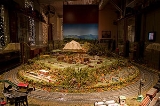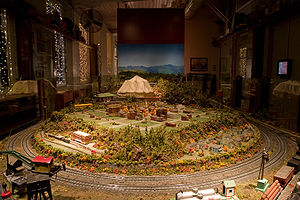
Eli Whitney Museum
Encyclopedia
The Eli Whitney Museum, in Hamden
, Connecticut
, is an experimental learning workshop for students, teachers, and families. The museum focuses on teaching experiments that are the roots of design and invention, featuring hands-on building projects and exhibits on Eli Whitney
and A. C. Gilbert.
The museum building was originally the Eli Whitney Armory, erected by Whitney to produce musket
s on a site he purchased on September 17, 1798. The factory was powered by water from the Mill River and produced muskets for the United States government
. On June 14, 1798, he contracted to produce 10,000 muskets to be delivered within 28 months at the cost of $134,000.00; in fact, it took ten years. When he signed the contract, Whitney had no factory, no workers and no experience in gun manufacturing. However, in a letter to Secretary of the Treasury
Oliver Wolcott, a fellow Yale University
graduate and friend, Whitney had written:
Whitney's factory was at the very forefront of the American Industrial Revolution
, using water-powered machinery, and it was among the first to have standardized, interchangeable parts
(for some but not all of its parts).
The museum is on the site of what was once known as Whitneyville, the manufacturing village constructed along the Mill River to house the workers at the Eli Whitney Armory, and made famous by painter William Giles Munson, who sketched the Whitney Armory in 1826, a year after Whitney died, creating at least 3 paintings from those sketches over the next two decades. The grounds still feature the old barn, stone coal shed and boarding house which date back to the days of Whitneyville and the operational armory, along with a reconstruction of Ithiel Town
's innovative lattice truss covered bridge
erected on the original pilings of one of the two bridges built to service the Eli Whitney Armory.
The Eli Whitney museum has exhibits on Whitney and his most famous invention, the cotton gin
. Other exhibits cover the historic site and A. C. Gilbert
, the inventor and toy maker best known for his invention of the erector set
. The museum is an experimental learning workshop for design and specializes in building projects for children blending science and invention. The site is located adjacent to the dam first built by Eli Whitney to power the armory, then raised to its current height by Eli Whitney Blake to provide more power. The museum also features water tables with canal locks and is adjacent to a water reservoir as well as hiking trails. In addition to visitor hours, the museum hosts summer and holiday programs and birthday parties, and is home to the annual Leonardo Challenge, a celebration of improvisational creativity that invites artists and designers from the New Haven, Connecticut
area to create uncommon inventions and designs from common objects, culminating in an exhibition of their creative efforts.

Hamden, Connecticut
Hamden is a town in New Haven County, Connecticut, United States. The town's nickname is "The Land of the Sleeping Giant." Hamden is home to Quinnipiac University. The population was 58,180 according to the Census Bureau's 2005 estimates...
, Connecticut
Connecticut
Connecticut is a state in the New England region of the northeastern United States. It is bordered by Rhode Island to the east, Massachusetts to the north, and the state of New York to the west and the south .Connecticut is named for the Connecticut River, the major U.S. river that approximately...
, is an experimental learning workshop for students, teachers, and families. The museum focuses on teaching experiments that are the roots of design and invention, featuring hands-on building projects and exhibits on Eli Whitney
Eli Whitney
Eli Whitney was an American inventor best known for inventing the cotton gin. This was one of the key inventions of the Industrial Revolution and shaped the economy of the Antebellum South...
and A. C. Gilbert.
The museum building was originally the Eli Whitney Armory, erected by Whitney to produce musket
Musket
A musket is a muzzle-loaded, smooth bore long gun, fired from the shoulder. Muskets were designed for use by infantry. A soldier armed with a musket had the designation musketman or musketeer....
s on a site he purchased on September 17, 1798. The factory was powered by water from the Mill River and produced muskets for the United States government
Federal government of the United States
The federal government of the United States is the national government of the constitutional republic of fifty states that is the United States of America. The federal government comprises three distinct branches of government: a legislative, an executive and a judiciary. These branches and...
. On June 14, 1798, he contracted to produce 10,000 muskets to be delivered within 28 months at the cost of $134,000.00; in fact, it took ten years. When he signed the contract, Whitney had no factory, no workers and no experience in gun manufacturing. However, in a letter to Secretary of the Treasury
United States Secretary of the Treasury
The Secretary of the Treasury of the United States is the head of the United States Department of the Treasury, which is concerned with financial and monetary matters, and, until 2003, also with some issues of national security and defense. This position in the Federal Government of the United...
Oliver Wolcott, a fellow Yale University
Yale University
Yale University is a private, Ivy League university located in New Haven, Connecticut, United States. Founded in 1701 in the Colony of Connecticut, the university is the third-oldest institution of higher education in the United States...
graduate and friend, Whitney had written:
- I am persuaded that Machinery moved by water adapted to this Business would greatly diminish the labor and facilitate the manufacture of this Article. Machines for forging, rolling, floating, boring, grinding, polishing, etc. may all be made use of to advantage.... (May 13, 1798)
Whitney's factory was at the very forefront of the American Industrial Revolution
Industrial Revolution
The Industrial Revolution was a period from the 18th to the 19th century where major changes in agriculture, manufacturing, mining, transportation, and technology had a profound effect on the social, economic and cultural conditions of the times...
, using water-powered machinery, and it was among the first to have standardized, interchangeable parts
Interchangeable parts
Interchangeable parts are parts that are, for practical purposes, identical. They are made to specifications that ensure that they are so nearly identical that they will fit into any device of the same type. One such part can freely replace another, without any custom fitting...
(for some but not all of its parts).
The museum is on the site of what was once known as Whitneyville, the manufacturing village constructed along the Mill River to house the workers at the Eli Whitney Armory, and made famous by painter William Giles Munson, who sketched the Whitney Armory in 1826, a year after Whitney died, creating at least 3 paintings from those sketches over the next two decades. The grounds still feature the old barn, stone coal shed and boarding house which date back to the days of Whitneyville and the operational armory, along with a reconstruction of Ithiel Town
Ithiel Town
Ithiel Town was a prominent American architect and civil engineer. One of the first generation of professional architects in the United States, Town made significant contributions to American architecture in the first half of the 19th century. He was high-strung, sophisticated, generous,...
's innovative lattice truss covered bridge
Covered bridge
A covered bridge is a bridge with enclosed sides and a roof, often accommodating only a single lane of traffic. Most covered bridges are wooden; some newer ones are concrete or metal with glass sides...
erected on the original pilings of one of the two bridges built to service the Eli Whitney Armory.
The Eli Whitney museum has exhibits on Whitney and his most famous invention, the cotton gin
Cotton gin
A cotton gin is a machine that quickly and easily separates cotton fibers from their seeds, a job formerly performed painstakingly by hand...
. Other exhibits cover the historic site and A. C. Gilbert
Alfred Carlton Gilbert
Alfred Carlton Gilbert was an American inventor, athlete, toy-maker and businessman. Born in Salem, Oregon and died in Boston, Massachusetts, Gilbert is best known as the inventor of the Erector Set.-Early life:...
, the inventor and toy maker best known for his invention of the erector set
Erector Set
Erector Set is the trade name of a toy construction set that is popular in the United States.It consists of collections of small metal beams with regular holes for nuts, bolts, screws, and mechanical parts such as pulleys, gears, and small electric motors.The brand name is currently used for...
. The museum is an experimental learning workshop for design and specializes in building projects for children blending science and invention. The site is located adjacent to the dam first built by Eli Whitney to power the armory, then raised to its current height by Eli Whitney Blake to provide more power. The museum also features water tables with canal locks and is adjacent to a water reservoir as well as hiking trails. In addition to visitor hours, the museum hosts summer and holiday programs and birthday parties, and is home to the annual Leonardo Challenge, a celebration of improvisational creativity that invites artists and designers from the New Haven, Connecticut
New Haven, Connecticut
New Haven is the second-largest city in Connecticut and the sixth-largest in New England. According to the 2010 Census, New Haven's population increased by 5.0% between 2000 and 2010, a rate higher than that of the State of Connecticut, and higher than that of the state's five largest cities, and...
area to create uncommon inventions and designs from common objects, culminating in an exhibition of their creative efforts.


